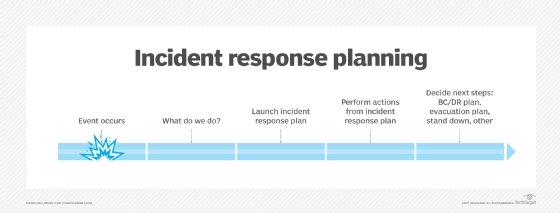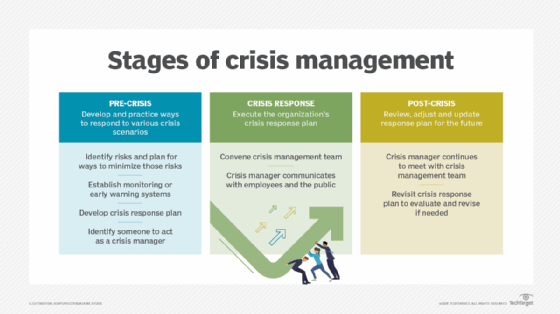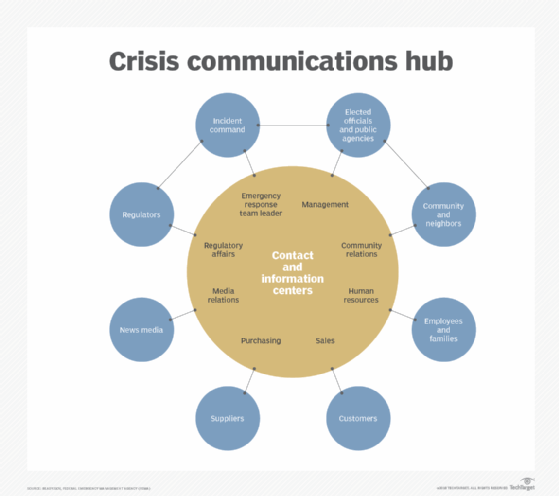What is crisis communication?
Crisis communication is a strategic approach to corresponding with people and organizations during a disruptive event. When a crisis occurs, proactive, quick, detailed communication is critical; a crisis communication strategy, plan and tools can ensure such communication happens.
The need for crisis communication
Every business should have a communication plan that documents the protocol for distributing information in a time of intense difficulty or danger. Because a business's reputation is at stake in those situations, it's important to impart information to the public -- and other stakeholders -- to ease concerns and counteract rumors or false information.

An organization should assume that it will experience a crisis at some point to improve planning and ensure proper crisis communication. What kind of response will occur may hinge on whether the situation is a "crisis," "event," or "incident." A crisis can be classified as an event or incident, but an event or incident may not be a crisis.
Merriam-Webster defines a crisis as "an unstable or crucial time or state of affairs in which a decisive change is impending, especially one with the distinct possibility of a highly undesirable outcome." The likelihood of a negative outcome often differentiates a crisis from events and incidents, and an organization should understand these distinctions.
Examples of crises
What events warrant crisis management planning? Examples include:
- on-site incidents with injury or property damage
- natural disasters such as earthquakes, hurricanes and tornadoes
- public incidents such as a terror attack or pandemic
- cybersecurity incidents, including ransomware exploits and data breaches -- especially those involving the disclosure of personally identifiable information (PII)..
As cyberattacks have become common, crisis communication is seen increasingly as a key element of business continuity and disaster recovery.
Recent wildfires across the country are examples of major crises because of negative outcomes such as property losses and deaths. The number of hurricane-based crises is often significant from June 1 to November 30 (hurricane season in the U.S.).
What are the 5 stages of a crisis?
A typical crisis includes five phases or stages:
Phase 1: Pre-crisis
The pre-crisis phase involves planning and education that can help an organization avoid or mitigate a crisis. The business must monitor emerging risks, anticipate possible crises, educate interested parties about possible risks and suggest actions to take. The business also reaches out to the necessary authorities and groups for collaboration and future help. It creates potential messages and communication systems and tests them; it identifies the crisis communication team that it will stand up during the event.
Phase 2: Initial
During the initial phase, the crisis has started, and the organization begins communicating. Because it can be a confusing, intense period, the organization should seek to provide clear, accurate direction; provide resources for more information; and calm fears. Even if information is sparse, crisis communication is still important to share what's known and reassure people that the organization is working on a solution.
Phase 3: Maintenance
In this phase, the organization provides crisis updates and details ongoing risks. It gathers feedback from anyone affected, corrects misinformation, and continues to assess and respond to the situation.
Phase 4: Resolution
When the situation has effectively ended, recovery and communication continue. The organization should communicate how it is recovering and rebuilding, and provide more detailed information about how the crisis happened. This is a good time to remind people how to be prepared for another crisis.
Phase 5: Evaluation
Two-way communication is important during crisis evaluation. The organization assesses how the response went and what could be improved. An after-action report comprehensively documents the crisis and response. The crisis communication plan is reviewed and updated as needed.
Any business experiencing a crisis must ensure communications flow during every phase of the crisis. Continuous, clear communication minimizes confusion and can mitigate chaos.

How is crisis communication done well?
Good crisis communication requires a comprehensive crisis communication plan. The plan should specify who will communicate the message and what communication channels will deliver it. The organization must ensure message consistency so as not to confuse target audiences and damage its reputation and brand.
Communicators must be ready to answer questions from various groups, including employees, customers and the media. Management should be kept informed about the questions being asked and the nature of social media posts about the crisis.
Engaging an outside PR firm can help a crisis-hit business interact with the media, but that may not be necessary if the organization resolves the crisis quickly enough.

What makes an actionable crisis communication plan?
A crisis communication plan is a comprehensive document that includes useful, timely, actionable details about:
- Audiences, or the people who should receive information
- Contact information for each audience
- Preparing and delivering the message
- Communication mediums
- Who should deliver the message(s).
Here are 10 more items associated with an actionable crisis communications plan:
- Identify potential audiences for crisis communication, including customers, employees, media, suppliers, company management, investors, and authorities such as law enforcement, government agencies or regulatory officials.
- Make contact information for key members of these audiences easily accessible during a crisis. This information should include stakeholder names, phone numbers, addresses and email addresses. These details allow responders to share important information about the crisis with the right people at the right time. It's important to update contact lists frequently.
- Pre-written, approved messages are an important feature of an actionable crisis communication plan. When a crisis hits, the pressure can make it hard to craft appropriate messages with the right words and tone. Mistakes in these areas can create confusion among stakeholders, increase chaos and exacerbate the crisis.
- Create message scripts or templates in advance, before a crisis occurs. Each template should explain what happened or is happening, how the crisis affects stakeholders, what actions stakeholders must take, and what actions the organization is taking.
- When preparing messages for distribution, consider including relevant data from prior risk assessments that identified the possible affect of future crises.
- The crisis communication plan should include a glossary of terms relevant to the crisis. This will ensure that the language used in all communications remains consistent and does not create confusion.
- Consider designating work areas for the media, with resources they may need, and provide access to an employee designated as the media relations contact.
- An automated emergency notification system (ENS) provides a way to rapidly disseminate messages to employees, stakeholders and others; it should be part of a crisis communications plan
- Many different options are available for delivering crisis messages. For example, social media is a quick way to reach hundreds or thousands of people. However, it shouldn't be the only method, because not everyone uses social media. Similarly, some people prefer to get updates using text messaging instead of phone calls.
- Establish a formal process for periodically reviewing, testing and updating the communication plan. Regular reviews can reveal flaws and prompt efforts to strengthen the plan and better prepare for a future crisis.
Crisis communications template
Having a template that forms the foundation to develop a crisis message is a good start to a crisis communications strategy. While each organization may have its own style and approach to internal and external message creation, initial messages in a crisis should answer the five Ws: What, Where, Who, When, and Why. Here's a message template useful for crafting the initial message:
| Structure |
Content |
| What |
Describe briefly what happened; use as much knowledge as is available. |
| When |
Describe the approximate time the event occurred; it may be necessary to also describe when it was declared a crisis. |
| Where |
Describe the location(s) where the crisis is occurring, providing as much detail as is available. |
| Who |
Describe who was affected, the number of people affected (employees and others), the number of injuries and fatalities (if known); list any corporate spokespersons. |
| Why |
Describe what caused the crisis, who was involved, and any other information; try to minimize any speculation. |
This initial template can be modified to deliver updated information in the hours following the crisis's occurrence, including but not limited to these 10 areas:
- Details on first responder activities.
- Details on law enforcement activities.
- Status updates on injuries and fatalities (including information for employee families).
- Messages delivered by a company spokesperson(s) or senior management
- Status of the crisis, and if any resolution is identified.
- Status of the company, e.g., if business has been suspended, how other company locations are operating, activation of any emergency recovery programs.
- Phone numbers to call for situation updates
- Information for smartphone users.
- Broadcast and social media information
- Updated communications to employees about where they should report for work, or to activate remote work.
The message content should be posted in whatever sequence the company favors and can vary with each subsequent message.
Important tools and resources for crisis communication
When a disruptive event occurs, it's useful to have a variety of tools and resources that can support effective crisis communications.. Examples include:
- Communication systems, including devices that can work without electrical power (landline phones, two-way radios and satellite phones).
- Automated emergency notification systems.
- Copies of emergency response, business continuity and crisis communication plans to guide emergency teams.
- Active social media accounts to post crisis updates.
- Site and building diagrams to facilitate quick evacuations.
- Forms for documenting events for later analyses and investigations.
- Message boards to share updates with employees.
- Webmaster tools or personnel to make quick website updates.
A call tree, also known as a phone tree, is also useful. In a manual call tree, one person calls a designated contact, then that person calls a designated contact, and so on. If the next person on the list cannot be reached, the caller continues with the next contact. Automated call tree software is also available to minimize the calling effort and time required. The software makes simultaneous calls to numerous people, helping to reduce or eliminate possible breaks in a call tree and to reach and inform the maximum number of people.
An emergency notification system (ENS) can automate these activities and provide data on the event, confirmation that messages were properly delivered and that recipients were able to reply, and numerous other metrics. ENS technology can be implemented as a standalone or cloud-based system. Many products, both commercial and open source/free, facilitate emergency communications.
Learn how to build a strong crisis communication team and how to implement a communication plan. Explore the roles and responsibilities of a crisis management team and the 12 key points that a disaster recovery plan checklist must include.






